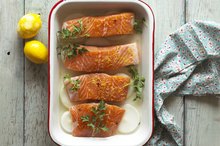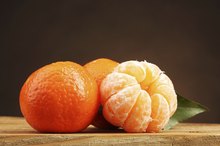What does fact checked mean?
At Healthfully, we strive to deliver objective content that is accurate and up-to-date. Our team periodically reviews articles in order to ensure content quality. The sources cited below consist of evidence from peer-reviewed journals, prominent medical organizations, academic associations, and government data.
- Mayo Clinic: Saw Palmetto - Basics
- Mayo Clinic: Saw Palmetto - Evidence
- National Instututes of Health – MedLine Plus: Saw Palmetto
The information contained on this site is for informational purposes only, and should not be used as a substitute for the advice of a professional health care provider. Please check with the appropriate physician regarding health questions and concerns. Although we strive to deliver accurate and up-to-date information, no guarantee to that effect is made.
Foods That Have Saw Palmetto
Palmetto is the common name for plant members of the genus Sabal and genus Serenoa. They are palm trees whose components are used for a variety of applications including wood pilings. Another widely known use for palmetto is as an herbal remedy, whose ingredients are derived from the species Serenoa repens and Sabal serrulata. Both species, referred to as “saw palmetto,” have been consumed by humans for centuries.
If you are experiencing serious medical symptoms, seek emergency treatment immediately.
Description
Saw palmetto grows as tree or shrub varieties, with all species bearing "saw-toothed" leaves that fan out. These plants grow in warmer regions, such as on the southeast coastline of the United States, ranging from South Carolina to Louisiana, including Florida. Saw palmetto is found in a wide array of habitats including coastal sand dunes, pinelands and moist forests. Saw palmetto produces flowers that yield berries. Initially, the berries are yellow; however, they turn black with blue undertones when they become ripe. It is the saw palmetto’s berries that are used for medicinal purposes 2.
- Saw palmetto grows as tree or shrub varieties, with all species bearing "saw-toothed" leaves that fan out.
History
Is Ashwagandha Good for Anxiety & Depression?
Learn More
Some of the earliest reports of saw palmetto’s use as an herbal remedy, traces back to the Mayans. At that time, saw palmetto was used to make tonics. The first reports of Native American use of saw palmetto for male urinary problems, was during the 1700s.
The medicinal use of saw palmetto was documented within the United State's conventional medical community for the first time in 1879. Georgia physician, Dr. J. B. Saw palmetto was listed as a drug by the U.S. Pharmacopeia and National Formulary during various periods between 1906 and 1950.
- Some of the earliest reports of saw palmetto’s use as an herbal remedy, traces back to the Mayans.
- The first reports of Native American use of saw palmetto for male urinary problems, was during the 1700s.
Consumption and Active Ingredients
Some alternative medical treatments come in the form of vitamins, minerals, enzymes and other related substances than can be found naturally in foods. However, saw palmetto berries are called “herbs” for common usage, and are not found in other foods beyond being a “food” type in itself 2. While early cultures ate saw palmetto berries directly off the tree/shrub, today, they are primary eaten in the form of dried berries, processed teas and liquid extracts to add to beverages. Saw palmetto also comes in the form of capsules and tablets 4. The primary ingredients that facilitate saw palmetto’s medicinal effects are plant sterols, fatty acids and flavonoids.
Effectiveness
Is Ginger an Herb or a Spice?
Learn More
As in ancient times, saw palmetto is still used today to treat a plethora of conditions such as:
- baldness
- colds
- asthma
- migraine headaches
- sore throat
However, according to the National Institutes of Health and Mayo Clinic, there is insufficient evidence to support many health claims attributed to saw palmetto. Conditions treated with saw palmetto that NIH, Mayo Clinic and the University of Maryland Medical Center have reported effective include benign prostate hyperplasia (BPH) and conditions related to BPH, such as urinary tract problems. Also, recent animal studies have shown a measure of success in treating prostate cancer.
Related Articles
References
- Encyclopedia: The Columbia Encyclopedia, Sixth Edition; Palmetto Palm; 2008
- Omeda Communications - Food Processing.com: “Nutrition Beyond the Trends: Saw Palmetto”; Mark Anthony, Ph.D; June 2007
- Encyclopedia: Dictionary of Plant Sciences; Sabal; Michael Allby; 1998
- Encyclopedia: Gale Encyclopedia of Medicine, 3rd ed.; Saw Palmetto; Ken Wells; 2006
- Saw Palmetto. Penn State Hershey. Milton S. Hershey Medical Center. Health Information Library
- Saw Palmetto. Natural Medicines Database. Professional Monograph.
- Saw Palmetto. Memorial Sloan Kettering Cancer Center. About Herbs, Botanicals, and Other Products.
- Agbabiaka TB1, Pittler MH, Wider B, Ernst E. "Serenoa repens (saw palmetto): a systematic review of adverse events." Drug Saf. 2009;32(8):637-47.
- Gerber GS1. "Saw palmetto for the treatment of men with lower urinary tract symptoms." J Urol. 2000 May;163(5):1408-12.
- Gordon AE1, Shaughnessy AF. "Saw palmetto for prostate disorders." Am Fam Physician. 2003 Mar 15;67(6):1281-3.
- Morgia G1, Mucciardi G, Galì A, Madonia M, Marchese F, Di Benedetto A, Romano G, Bonvissuto G, Castelli T, Macchione L, Magno C. "Treatment of chronic prostatitis/chronic pelvic pain syndrome category IIIA with Serenoa repens plus selenium and lycopene (Profluss) versus S. repens alone: an Italian randomized multicenter-controlled study." Urol Int. 2010;84(4):400-6.
- National Institutes of Health. "Saw palmetto: MedlinePlus Supplements." February 2015.
- Prager N1, Bickett K, French N, Marcovici G. "A randomized, double-blind, placebo-controlled trial to determine the effectiveness of botanically derived inhibitors of 5-alpha-reductase in the treatment of androgenetic alopecia." J Altern Complement Med. 2002 Apr;8(2):143-52.
- Tacklind J1, Macdonald R, Rutks I, Stanke JU, Wilt TJ. "Serenoa repens for benign prostatic hyperplasia." Cochrane Database Syst Rev. 2012 Dec 12;12:CD001423.
Writer Bio
Andrea Sigust began writing professionally in 1994, authoring user-friendly manuals, reference guides and information sheets while working at a hospital. After years of working in industries ranging from health care to telecommunications, Sigust became a writer. She specializes in the sciences and holds a Bachelor of Science in journalism from the University of Maryland.









